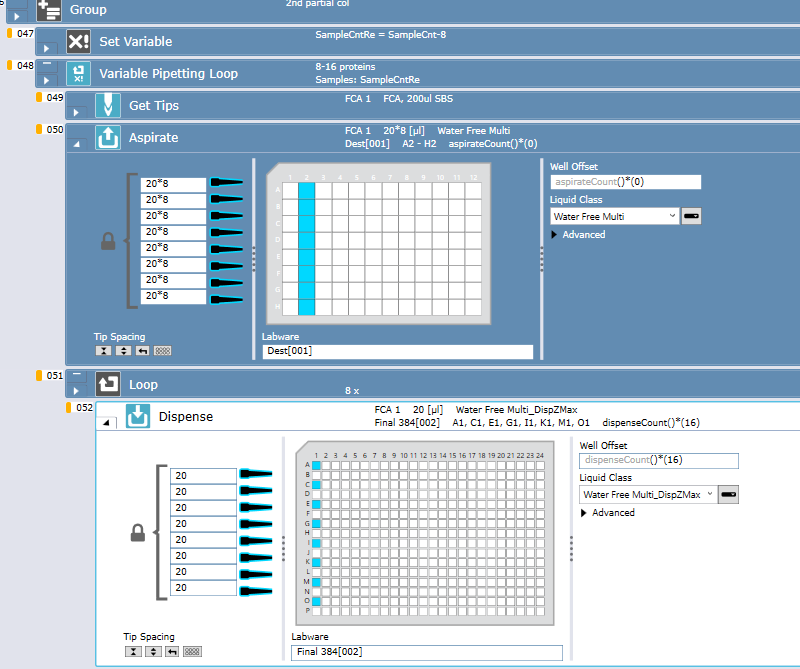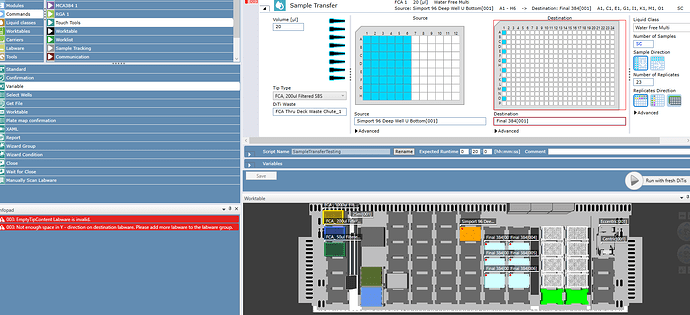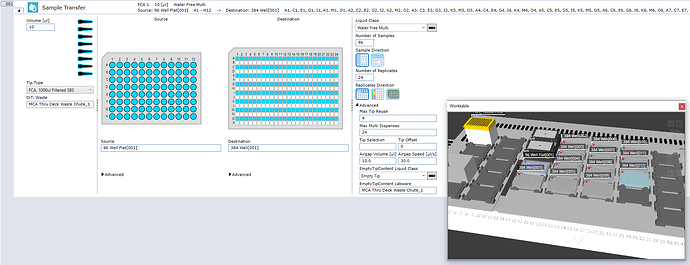Hi everyone,
I’m working on a script that cherrypicks samples into a single destination plate, then normalizes them in that plate. In the second part of the script, I am using the FCA to add samples from the normalized plate into final 384-well plates. Downstream applications require the final 384-plates to hold 8 samples each, replicated down alternative rows. So sample 1 would be multidispensed in the 384 down row A, sample 2 would be multidispensed down row C, and so forth.
I’ve forced a way for the fluent to do this with up to 48 samples. But there has to be a better way! Does anyone have experience trying to do something like this? I haven’t seen any commands that might let me “design” the final 384-plate map so that it only holds 8 samples each. I’ve labeled the 384-plates consecutively and was hoping I could accomplish this with reagent distribution with 23 replicates across the rows, but when I try to run I get an error about Y-spacing. Unsure why, because I’m easily able to multidispense the way I want by just looping the dispenses outside of the smart commands.
Any leads would be greatly appreciated!
Thank you!
Apologies but a plate map helps here.
Is this all FCA? Have you tried using Transfer Individual Volume?
i would try “Sample Transfer” wizard - you can define row wise replicates x 24 for each source well aspiration,
it should allow you to cycle through various destination plates until all source wells are pipetted,
the destination plate naming convention should be numerical in series e.g. [001],[002]
i ran a quick test and the temp script created appears to pipette into appropriate wells
all plates must be within X & Y range of the FCA - so keep plates away from rear most and front most sites - 12 x destination plates
hope this works out - the alternate is a bit more complex!
Also shout out to the Sample Transfer GWL command, it has pretty good customization capabilities in a worklist format!
@luisvillaautomata @Optimize Thank you both for the feedback! Attaching a couple screen grabs here for better visual.
The first attachment is how I’m forcing it to work now, using the var pip loop in case I have incomplete columns. The same labware and positioning is used in both attachments, but for some reason when I try to use reagent/sample transfer I get this ‘not enough space in Y’ error shown in the picture. Normally I would think I need to tweak something with my 384-plate definition, but since it has no problem performing it with the variable pip loop, I’m not sure what the hold up is here.
I haven’t done much with the GWLs. I don’t know how to code and this has me visually intimidated, but I will need to get over that at some point!
1 Like
If you highlight the entire contents of Rows A, C, E etc - it should validate
That looks great! I would also advice you try out a GWL. Most people make them on Excel.
Oh wow! Sample Transfer almost makes this insanely simple. Thanks for showing me how to use it! I tested it out and the only issue is I’ve defined the EmptyTipContent labware as the source plate hoping to retain what’s leftover in my source. All the tips want to empty tip into A1 when I’d like them to empty into the wells they were aspirated from. I think I’ve had this issue before, I’ve tried using functions with labware in the empty tip line, but it doesn’t seem to like that.
Before I checked back on this post I did get another way of accomplishing what I need figured out! How I was setting it up before was super long and tough to modify, but using a full column and partial column variable with floor() cut it down to like 30 lines!
Thank you both for your help!!
2 Likes


